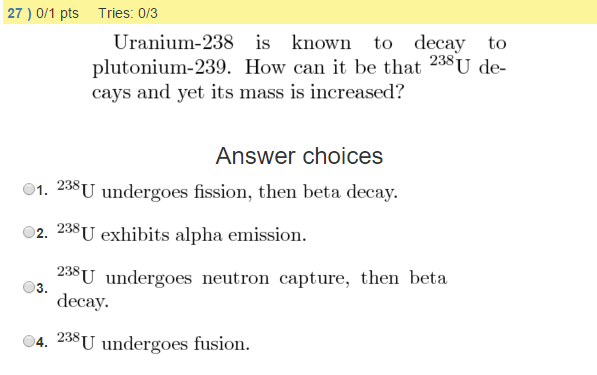How can uranium-238 decay to plutonium-239 but its mass still increases?

1 Answer
It undergoes neutron capture, then two beta decays.
Explanation:
The trick here is to realize that the two nuclides have equal mass numbers.
As you know, uranium has an atomic number equal to
"no. of neutrons" = 238 - 92 = 146
neutrons inside its nucleus. Plutonium, on the other hand, has an atomic number equal to
"no. of neutrons" = 239 - 94 = 145
Now, the fact that uranium-238 undergoes neutron capture may seem counterintuitive at this point, but the key here is actually the beta decay that follows this neutron capture or, more specifically, the two beta decays that follow.
When uranium-238 captures a neutron, it forms uranium-239
""_ (color(white)(1)92)^238"U" + ""_ 0^1"n" -> ""_ (color(white)(1)92)^239"U"
Now, when a nuclide decays via beta decay, or beta minus decay, a neutron located inside the nucleus is converted to a proton and an electron,
This will change the atomic number of the nuclide, but leave its mass number, which is the number of protons and neutrons located inside the nucleus, unchanged.
The first beta decay will get you
""_ (color(white)(1)92)^239"U" -> ""_ (color(white)(1)93)^239"Np" + ""_ (-1)^(color(white)(-)0)"e" + bar(nu)_"e"
Uranium-239 will decay to neptunium-239 by way of beta decay. The second beta decay will get you
""_ (color(white)(1)93)^239"Np" -> ""_ (color(white)(1)94)^239"Pu" + ""_ (-1)^(color(white)(-)0)"e" + bar(nu)_"e"
Neptunium-239 undergoes beta decay to form plutonium-239.
As you can see, one neutron is being lost with every beta decay, but because it is being replaced by a proton, the mass number remains unchanged.

